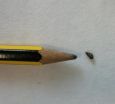The study was conducted by researchers at New York University's Center for Neural Science, the State University of New York (SUNY) Downstate Medical Center, NYU Langone Medical Center, and the Nathan S. Kline Institute for Psychiatric Research.
Researchers have aimed to address human neuropsychiatric impairments, such as schizophrenia, through mental training—for example, executive function exercises that teach patients to focus their attention and selectively recall important information. Historically, these methods, collectively titled cognitive remediation, have been of limited value because they have been applied to patients whose conditions are too advanced to address.
However, early intervention, in principle, is a viable approach to treatment. This is because of two facts. One, our brains continue to develop and grow up until the age of about 20. Two, experience can have the powerful effect of tuning neural circuits. Taken together, it may be possible to use mental training to harness the young brain's developmental potential to compensate for abnormal neural circuits.
"This means you have a window to intervene prior to a neural system manifesting functional abnormality and becoming unchangeable," explained André Fenton, a professor at NYU's Center for Neural Science and one of the study's co-authors.
Fenton, who is also an associate professor of physiology and pharmacology at SUNY Downstate, added, "If you can detect an abnormality in the brain early enough, you can redirect the trajectory of development and train the younger brain to solve problems that will confront the adult brain."
But a question that has vexed researchers is what kind of training can yield dividends? This matter was the focus of the Neuron study.
The research team conducted its study on laboratory rats at two different stages of life—at adolescence, or 35 days old, which is the human equivalent of 13 years of age, and as young adults, or 60 days old, which is the human equivalent of just over 20 years, which is the typical onset of schizophrenia symptoms.
Through a series of experiments, the researchers examined the behavior and brain physiology of rats with normally functioning brains and those whose brains had been impaired by lesions, which model the effects of schizophrenia.
In the initial experiment, they used both normal rats and those whose brains had been impaired by lesions, so-called neonatal ventral hippocampus lesion (NVHL) rats, to model impaired cognitive control, one of the core executive function deficits in schizophrenia and other types of mental illness. The rats had to learn to properly navigate a small disk-shaped carousel in order to avoid stepping in an area that would result in a mild electric shock. On the rotating carousel, the rats were given two types of spatial cues—those that were stationary and necessary to use in order to avoid the area in which they'd receive the electric shock and those that were rotating and irrelevant to this avoidance. The test was designed to mimic the executive function challenges faced by those with schizophrenia—the inability to distinguish relevant and irrelevant information.
They first tested 60-day old rats. While the normal rats quickly learned to differentiate relevant from irrelevant cues, thereby avoiding the shock zone, the NVHL rats had difficulty doing so. However, with enough training or repetition, the adult NVHL rats eventually learned to avoid the shock zone, but they were again impaired if the task was changed so they had to avoid shock in a new part of the carousel. This experiment mimicked what is often seen with human schizophrenia patients—that cognitive remediation can improve cognition, but not generally. Improvements are typically limited to particular training tasks, which makes cognitive remediation of limited clinical utility.
In the next experiment, the researchers tested whether preemptive cognitive training, if it occurred early enough in life, would be beneficial in adulthood by diminishing the adult cognitive control impairment. They also made sure to evaluate whether the early cognitive remediation for a single task can help the adult NVHL rats complete other tasks instead of the benefits being limited to mastering the training task.
To test these matters, the researchers gave control and NVHL rats two kinds of experiences when they were adolescents—at 35 days old. Half the rats in each group received the training to use relevant and ignore irrelevant information to avoid shock in the rotating carousel. As adolescents, the NVHL rats were not impaired; they learned as well as the control group did. The other half of the rats was put on the carousel for the same amount of time, but they were never shocked and so not given an explicit cognitive challenge.
When the NVHL rats were 60 days old, the researchers gave all of them a variety of tasks beginning with a test in a T-shaped maze. The rats first had to learn to go to the left, rather than the right, in order to avoid a mild electric shock. All the rats initially performed well as there was no need for cognitive control. But when the shock was switched to the left, it required cognitive control to ignore the now irrelevant memories of going left. The results showed that the NVHL rats without the early cognitive training were impaired to switch to running to the newly safe portion of the maze. In contrast, all the other rats, including the NVHL rats that had been subject to preemptive cognitive training, switched more successfully than the NVHL rats that had no such training. The same pattern of results was seen in subsequent tests using the carousel task, confirming that the preemptive cognitive training in adolescence was generally beneficial into adulthood, overcoming the cognitively debilitating effects of the persistent brain damage that the NVHL rats sustained.
Not only did preemptive training in adolescence prevent the adult deficits in cognitive control, but when the researchers investigated electrical brain function they observed that the preemptive cognitive training had also corrected how the damaged brain was operating. The researchers recorded the oscillatory electrical activity in different parts of the brain and found that in normal rats that were doing the carousel task, the electrical fluctuations were strongly synchronized between the left and right hippocampi, a part of the brain that is crucial to memory and navigating space. Similarly, in the NVHL rats with preemptive cognitive training in adolescence, neural synchrony in the left and right hippocampi was as strong as the control rats during the control task. These findings indicate that the early cognitive intervention also allowed the brain to function normally during the cognitive challenge, despite the enduring brain damage.
"Our findings show that if you focus the young brain on gaining a certain kind of experience, then we can train it to solve certain types of problems that will confront the adult brain," explained Fenton. "But this must be done at a time when the brain is flexible in order to carve out pathways to gain competencies of a normal brain."
###
The study's other co-authors were: Heekyung Lee and Hsin-Yi Kao of SUNY Downstate Medical Center; Dino Dvorak of SUNY Downstate Medical Center and the Polytechnic Institute of NYU; Áine Duffy of the Nathan S. Kline Institute for Psychiatric Research; and Helen Scharfman of NYU Langone Medical Center.
The study was supported by a grant from the National Institute of Mental Health, part of the National Institutes of Health.
END



